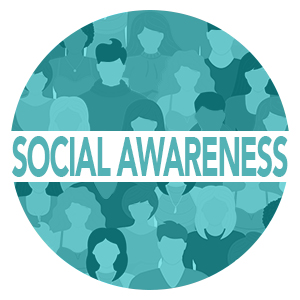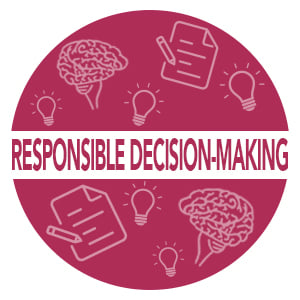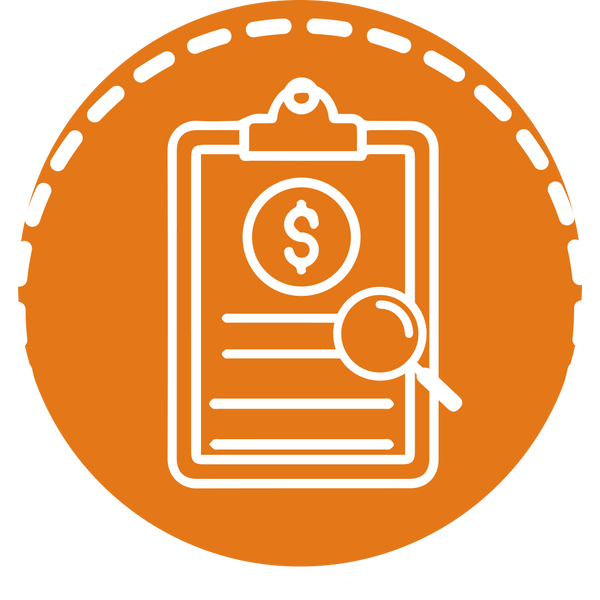
The STEM-SEL Connection
How STEM Can Promote Social and Emotional Learning
There is a growing recognition of the importance of integrating STEM education and social and emotional learning (SEL) for comprehensive holistic learner development. The fusion of these two approaches equips learners with skills to tackle the challenges of a rapidly changing world.
STEM education sparks critical thinking, curiosity, problem-solving and analytical thinking in learners. SEL is an educational framework that focuses on important life skills such as self-awareness, self-management, social awareness, relationship skills and responsible decision-making.
When carefully crafted and executed, STEM-focused learning can effectively enhance essential SEL skills.
Five Key Social and Emotional Learning Skills Developed During STEM Programming:

STEM challenges are opportunities for learners to engage in self-reflection. Learners develop an understanding of their strengths and weaknesses as they tackle complex problems. At PCS Edventures, we like to call it “failing forward” because every stumble is a chance to grow. A learning environment that encourages a growth mindset cultivates habits of grit and self-awareness.

STEM spaces provide a laboratory for planning, organization and perseverance. STEMists learn to set goals and manage their time efficiently. STEM challenges serve as maps for embarking on adventures, practicing perseverance and adaptability. PCS Edventures’ STEM programming offers endless opportunities and experiences to practice perseverance and self-management skills.

STEM learning is so much more than calculating, designing and experimenting. STEM activities often involve teamwork, collaboration and communication. In a collaborative STEM environment, learners grow to appreciate the diverse strengths and perspectives of their peers. STEM spaces are a place where everyone’s talents can shine!

Teamwork is key in many STEM projects because it drives success. When learners team up, they are not just exploring the ins and outs of science and technology; they are also leveling up their relationship skills. We're talking about better communication, stronger cooperation and effective conflict-resolution skills. These talents aren't just handy in the lab; they assist in real-life situations, turning everyone into well-rounded achievers.

STEM involves critical thinking and problem-solving. Learners engage in analyzing data, identifying patterns and making informed decisions. The decision-making skills honed through STEM tasks aren't limited to science or technology; they're also incredibly useful in everyday life. Thinking critically and solving problems are key parts of SEL that help learners in and out of traditional learning environments.
PCS Edventures Can Help You Promote the STEM–SEL Connection
Unsure where to start in the STEM–SEL connection? Try one of our free STEM design challenges with your learners. PCS Edventures’ 5 Fun and Easy End-of-Year STEM Activities provide learners with STEMist skills such as brainstorming, problem-solving, designing and experimenting.
Both the Popsicle Rescue and the Solar Oven activities require self-management skills such as planning, organizing and persevering. Additionally, design challenges encourage learners to work collaboratively, communicate effectively with team members and hone problem-solving skills. These activities cultivate an environment that encourages learners to embrace diverse perspectives and effectively navigate group dynamics.
If you are looking to dive deeper into the STEM–SEL connection, check out Build A Better World. Learners elevate their engineering design thinking and SEL skills by exploring natural disasters up close.
Through collaborative efforts, learners tackle structural challenges and analyze the environmental consequences of various choices. Environmental sustainability projects encourage learners to develop a keen sense of social awareness as they explore the impact of their actions on the world.
These STEM experiences provide hands-on learning experiences and a platform for the development of crucial social and emotional skills, contributing to the holistic growth of students.
What Are the Benefits of Integrating STEM and SEL?
The integration of STEM with SEL creates an educational powerhouse that goes beyond textbooks and learning spaces. Let's break down how this dynamic combination accomplishes various positive outcomes:
Improved Academic Performance and Engagement:
STEM programming combined with SEL creates a winning formula that's proven to boost academic success. Insights from the Collaborative for Academic, Social, and Emotional Learning (CASEL) consistently confirm the positive impact of SEL on academic achievement. Findings show learners actively involved in SEL demonstrate superior performance on tests, increased completion of homework and better attendance.
Increased Motivation and Intrinsic Drive to Learn:
SEL in STEM can enhance intrinsic motivation by fostering a sense of autonomy and purpose in learners. When learners engage in activities that allow them to explore their interests, set goals and take ownership of their learning, they feel a greater sense of control over their education. Additionally, as they develop social and emotional skills such as perseverance, self-efficacy and resilience through STEM challenges, they become more confident in their abilities to overcome obstacles and achieve success.
This intrinsic motivation stems from the satisfaction of mastering new skills and tackling meaningful problems, ultimately leading to more enthusiasm for learning. By integrating SEL and academics through inquiry-based learning, the social, emotional and academic needs of all learners are prioritized.
Better Preparation for Future Careers and Challenges:
The dynamic duo of STEM and SEL isn't just about boosting grades — it's about setting learners up for success in the ever-evolving job market. According to the U.S. Department of Commerce, fields like computer and mathematics are expected to see a whopping 15.2% growth from 2022−2032. At the same time, employers are consistently identifying soft skills such as communication, self-management, collaboration and problem-solving as highly sought after. So when individuals hit the job market, they're not just armed with know-how; they're also equipped with the empathy, resilience and teamwork skills needed to thrive in any career path.
Development of Well-Rounded, Responsible Individuals:
The combination of STEM and SEL contributes to the comprehensive holistic development of learners, nurturing not only their academic abilities but also their social and emotional intelligence. By integrating SEL and academics, educators address the social, emotional and academic needs of all learners. More on holistic learning: 5 Ways STEM Connects to Holistic Learning.
Tips to Promote the STEM–SEL Connection in Your Program:
1. Create a Learning Space That Fosters Emotional Safety and Risk-Taking
- Cultivate Trust and Connection: Build strong relationships with learners through open communication and mutual respect. This trust creates a safe space for learners to share their thoughts and ideas without fear of judgment.
- Embrace Inclusivity and Diversity: Celebrate the unique backgrounds and perspectives of all learners to cultivate an inclusive culture. Valuing diversity fosters emotional safety and ensures that each individual feels accepted.
- Reinforce Positive Behavior: Set clear expectations for behavior and provide positive reinforcement to encourage a supportive learning environment. By integrating SEL principles into classroom management, learners feel empowered to take academic risks.
- Encourage Reflection: Incorporate regular opportunities for reflection to help learners process their emotions and experiences. Activities such as journaling and mindfulness promote self-awareness and emotional regulation.
- Foster a Growth Mindset: Promote a growth mindset where mistakes are viewed as opportunities for learning and growth. Encouraging learners to embrace challenges and persevere cultivates a culture of resilience.
2. Measure SEL Growth Alongside Academic Success
- Include SEL in Assessments: Enhance your assessments by adding SEL competencies such as self-awareness, social awareness and decision-making. This gives a fuller picture of how learners are developing.
- Watch and Give Feedback: Keep an eye on how learners interact socially and emotionally and give them some friendly pointers. This qualitative data gives you a deeper understanding of their SEL growth.
- Try Special SEL Assessments: Explore tools made just for assessing SEL skills. These assessments give you a clear picture of how learners are doing socially and emotionally.
- Let Learners Reflect: Get learners involved in their own SEL growth! Have them assess themselves, set goals or reflect in journals. It's a great way to promote accountability.
- Team Up with Parents: Keep parents in the loop about both academic and SEL progress. When educators and families work together, it creates a strong support system for learners’ overall development.
By integrating these strategies, educators can create an environment that supports academic excellence and nurtures the social and emotional well-being of learners, fostering a balanced and holistic approach.
Free Resources to Help You with Your STEM - SEL Journey:
- 5 Ways STEM Leads to Outstanding Classroom Management
- A Noteworthy Anecdotal Records Kit
- The Mindful Student STEAM activities to promote emotional wellness
- Growth vs. Fixed Mindset
- Failure is Advantageous
- 5 Ways STEM Connects to Holistic Learning
- Executive Functioning Skills: Learner Checklists
Conclusion:
The integration of STEM and SEL offers numerous benefits for learners' holistic development. By combining STEMist skills with emotional intelligence, learners excel academically while becoming resilient, empathetic individuals ready to tackle real-world challenges.
Have you applied the STEM–SEL approach in your educational endeavors? We're eager to hear about your positive experiences and the impact you've witnessed on your learners. Whether it's a specific activity that sparked remarkable collaboration or an instance where social and emotional skills visibly flourished, your insights could inspire fellow educators on this journey.
Thank you for sharing your experiences and being a part of the collaborative effort to enhance the educational journey for all learners! Become a subscriber for access to our free resource, Think Like a STEMist. Challenge learners to explore STEM in their own world with these ten activities that will spark curiosity and critical thinking.

How have you applied SEL within your STEM programming?
We'd love to hear from you! Tell us in the comments below:

Author: Kim Turner
A life-long learner and lover of education, Kim has 30 years of education experience with STEM labs, gifted and talented courses and more!









